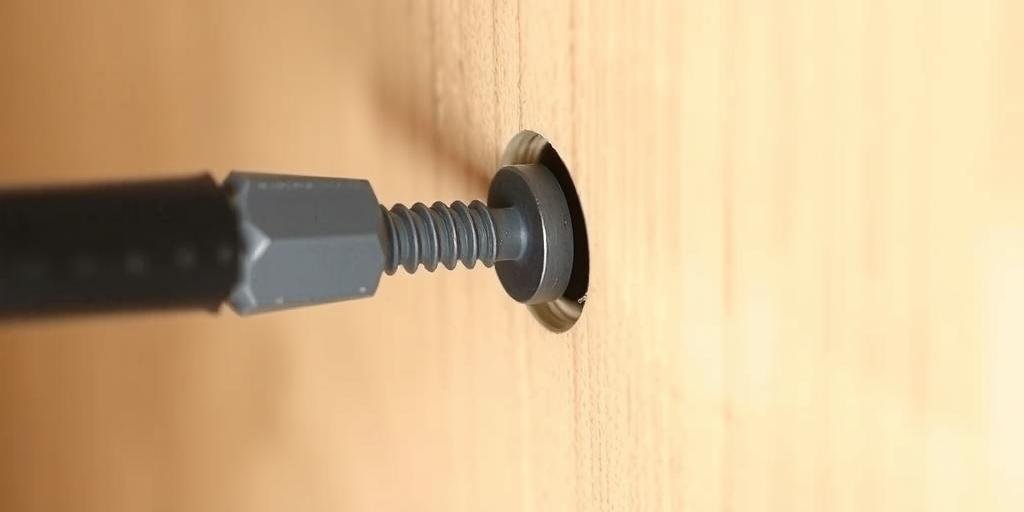Is your cabinet door hanging loose because of a stripped screw hole? Don’t rush to replace the entire cabinet! With some simple techniques and the right tools, you can easily repair stripped screw holes in wood cabinets and restore their strength. This comprehensive guide will walk you through effective methods, provide handy tips, and answer common questions to help you fix your cabinet quickly and efficiently.
Understanding Stripped Screw Holes in Wood Cabinets
A stripped screw hole occurs when the wood fibers inside the hole have worn away or broken, causing the screw to lose grip. This typically happens due to:
- Over-tightening screws
- Repeated removal and reinsertion of screws
- Using screws that are too large or too small
- Natural wear and tear over time
Recognizing the signs of a stripped hole early can help prevent further cabinet damage.
Tools and Materials Needed
| Tools | Materials |
|---|---|
| Screwdriver or drill | Wood glue |
| Utility knife | Wooden toothpicks, golf tees, or dowels |
| Hammer | Wood filler or epoxy (optional) |
| Clamps (optional) | Sandpaper |
| Drill bits | Replacement screws (if needed) |
Gather these supplies before starting your repair for a smoother process.
Methods to Fix a Stripped Screw Hole
1. Using Toothpicks and Wood Glue
This is one of the quickest and most cost-effective methods for repairing a stripped screw hole in a wood cabinet door or frame.
Steps:
- Remove the loose screw.
- Apply a small amount of wood glue inside the stripped hole.
- Insert several wooden toothpicks coated in glue tightly into the hole until it’s packed.
- Break or cut off the excess toothpicks flush with the cabinet surface.
- Let the glue dry completely (usually a few hours).
- Reinsert the screw carefully and tighten.
This method restores grip by giving the screw fresh material to bite into.
2. Filling with Wooden Dowels
For a more durable and permanent fix, especially for larger holes or heavy cabinet doors, use a wooden dowel.
Steps:
- Remove the screw and clean out loose debris.
- Drill out the stripped hole to slightly larger than the dowel diameter for a snug fit.
- Apply wood glue around the dowel and insert it into the hole.
- Tap gently with a hammer to seat it fully.
- Wipe away excess glue.
- Allow the glue to dry thoroughly (ideally overnight).
- Trim the dowel flush with the cabinet surface using a utility knife or saw.
- Drill a new pilot hole into the dowel.
- Reinsert the screw.
This repair effectively creates a new, strong anchor point for your screw.
3. Using Golf Tees
Golf tees work similarly to dowels but are often more accessible for quick fixes.
Steps:
- Remove the screw.
- Apply wood glue to a wooden golf tee.
- Insert the tee into the stripped hole and tap gently until snug.
- Break or saw off the excess part sticking out.
- Allow the glue to dry fully.
- Drill a small pilot hole into the tee.
- Drive the screw into the new hole.
This method is sturdy and ideal if you have leftover golf tees at home.
4. Using Wood Filler or Epoxy
For minor damage or when you lack dowels and toothpicks, wood filler or epoxy putty can be a good alternative.
Steps:
- Remove the screw and clean the hole thoroughly.
- Mix the filler or epoxy as per instructions.
- Pack the hole tightly with the filler.
- Wipe away any excess material.
- Allow to cure fully (refer to product drying times).
- Drill a new pilot hole.
- Install the screw carefully.
This approach works well for light to moderate loads but may not be as durable for heavy cabinet doors.
Choosing the Best Method
Here’s a quick comparison of the above methods to help you decide:
| Method | Best For | Durability | Time Required |
|---|---|---|---|
| Toothpicks & Glue | Quick, light repairs | Moderate | Short |
| Wooden Dowels | Heavy doors, permanent fix | High | Longer |
| Golf Tees | Medium repairs, easy access | High | Moderate |
| Wood Filler/Epoxy | Small holes, cosmetic fixes | Low to moderate | Moderate |
Pro Tips for Successful Repair
- Let glue cure fully before reinserting the screw to ensure maximum strength.
- Always drill a pilot hole into your new plug to prevent wood splitting.
- If possible, use a slightly longer or thicker screw for added grip.
- Use clamps if necessary to hold parts together while glue dries.
- For visible areas, sand and touch up with matching stain or paint after repair.
Preventing Future Stripped Holes
After fixing your cabinet, taking some precautions can prevent future issues:
- Avoid over-tightening screws.
- Use the correct screw size and length.
- When possible, use cabinet hardware designed to distribute stress evenly.
- Inspect hinges and hardware periodically for loosening.
- Consider upgrading to stronger screws or inserts if you notice recurring problems.
Alternative Fixing Options
Using Threaded Inserts
For a professional, long-lasting fix, especially in high-stress areas, consider installing metal threaded inserts. These expand inside the wood and provide durable threads for screws. They require drilling a larger hole and may need special tools but offer superior holding power.
Replacing with Larger Screws
If the hole is only slightly stripped, sometimes simply using a slightly thicker or longer screw can provide enough grip without further repairs. Be cautious not to split the wood.
FAQs About Fixing Stripped Screw Holes in Wood Cabinets
Can I use super glue instead of wood glue?
While super glue can work in a pinch, wood glue is designed to bond wood fibers effectively and provides a stronger, more durable hold. It also allows more working time during repair.
How long should I wait before reinserting the screw?
It’s best to wait at least a few hours, but ideally overnight, to allow the glue or filler to fully cure. This ensures maximum strength and durability.
Is wood filler strong enough for heavy cabinet doors?
Wood filler alone is typically not strong enough to support heavy loads. For doors and hinges, use dowels or golf tees for a more robust fix.
What if the stripped hole is on a visible cabinet surface?
Use a wood plug or dowel, then sand it flush and color-match with stain or paint to blend seamlessly with your cabinet finish.
Can I prevent stripped holes when installing new cabinets?
Yes. Always drill pilot holes before inserting screws, avoid over-tightening, and use the appropriate hardware for the cabinet’s weight and material.
Should I replace the screw after repair?
If the screw is bent, rusted, or worn, it’s a good idea to replace it with a new, properly sized screw for optimal holding power.
Conclusion
Fixing a stripped screw hole in a wood cabinet is a straightforward DIY project that can save you money and extend the life of your cabinets. Whether you opt for toothpicks, dowels, golf tees, or fillers, the key is to ensure a snug, secure fit for your screws. With patience and the right materials, your cabinet will be as sturdy as new in no time. Don’t forget to maintain your cabinets regularly to prevent future issues!
Now that you know how to repair stripped screw holes, tackle that wobbly cabinet today and restore its strength and beauty effortlessly.

